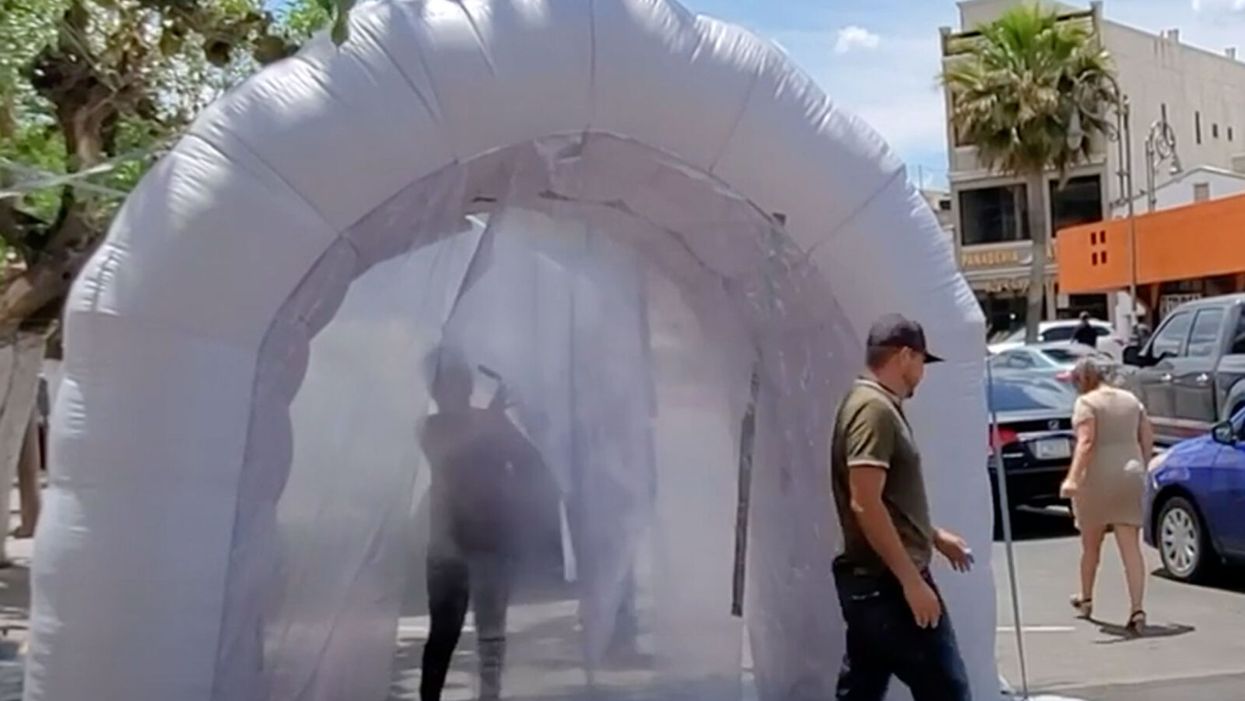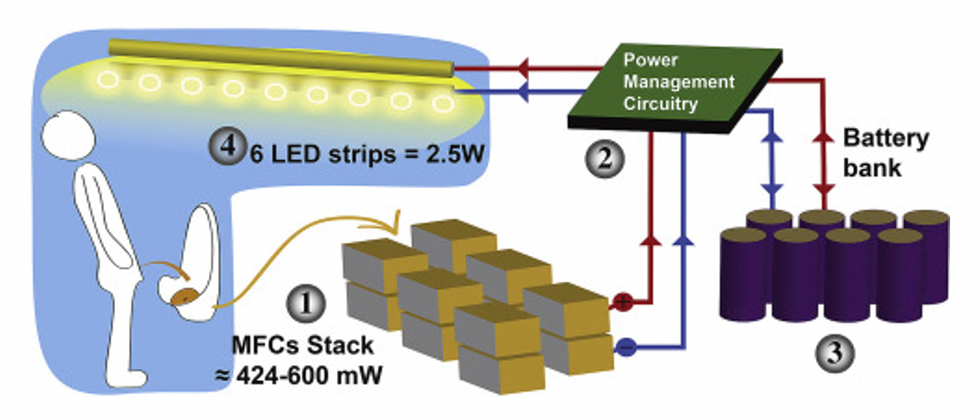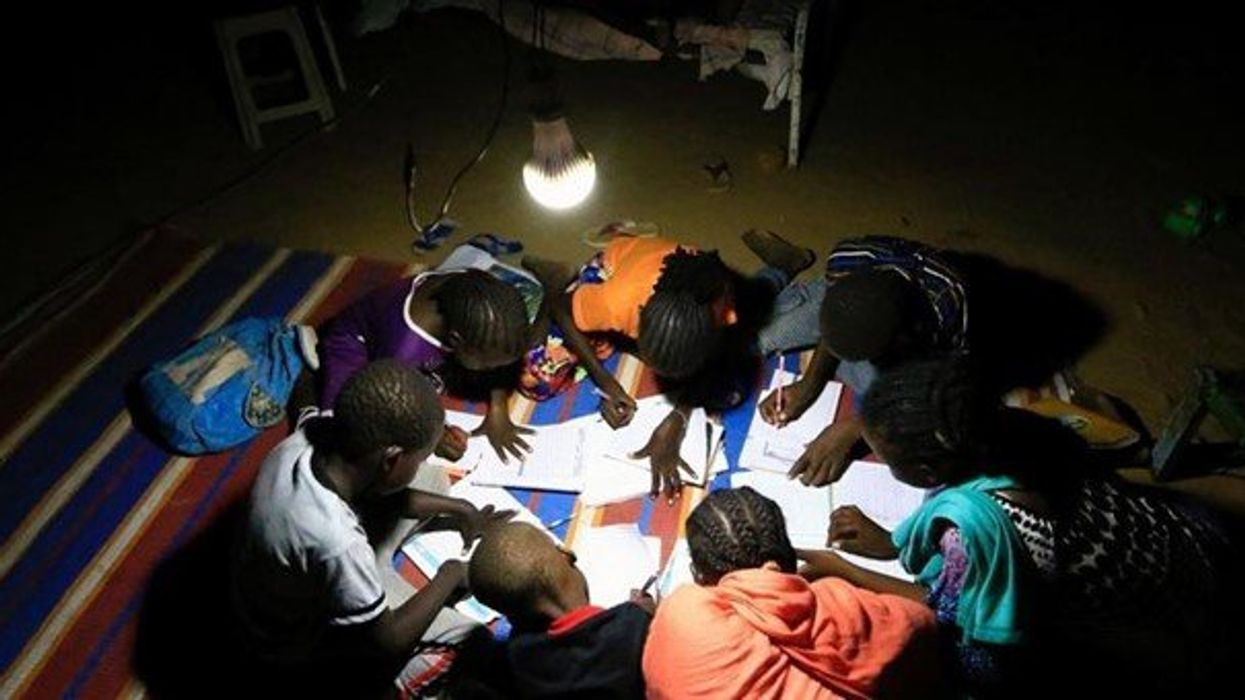“Disinfection Tunnels” Are Popping Up Around the World, Fueled By Misinformation and Fear

A screenshot of a video published by The Guardian of a tunnel used in a Mexican border town to "disinfect" U.S. visitors in an attempt to prevent them from spreading the coronavirus.
In an incident that sparked widespread outrage across India in late March, officials in the north Indian state of Uttar Pradesh sprayed hundreds of migrant workers, including women and children, with a chemical solution to sanitize them, in a misguided attempt to contain the spread of the novel coronavirus.
Since COVID-19 is a respiratory disorder, disinfecting a person's body or clothes cannot protect them from contracting the novel coronavirus, or help in containing the pathogen's spread.
Health officials reportedly doused the group with a diluted mixture of sodium hypochlorite – a bleaching agent harmful to humans, which led to complaints of skin rashes and eye irritation. The opposition termed the instance 'inhuman', compelling the state government to order an investigation into the mass 'chemical bath.'
"I don't think the officials thought this through," says Thomas Abraham, a professor with The University of Hong Kong, and a former consultant for the World Health Organisation (WHO) on risk communication. "Spraying people with bleach can prove to be harmful, and there is no guideline … that recommends it. This was some sort of a kneejerk reaction."
Although spraying individuals with chemicals led to a furor in the South Asian nation owing to its potential dangers, so-called "disinfection tunnels" have sprung up in crowded public places around the world, including malls, offices, airports, railway stations and markets. Touted as mass disinfectants, these tunnels spray individuals with chemical disinfectant liquids, mists or fumes through nozzles for a few seconds, purportedly to sanitize them -- though experts strongly condemn their use. The tunnels have appeared in at least 16 countries: India, Malaysia, Scotland, Albania, Argentina, Colombia, Singapore, China, Pakistan, France, Vietnam, Bosnia and Herzegovina, Chile, Mexico, Sri Lanka and Indonesia. Russian President Vladimir Putin even reportedly has his own tunnel at his residence.
While U.S. visitors to Mexico are "disinfected" through these sanitizing tunnels, there is no evidence that the mechanism is currently in use within the United States. However, the situation could rapidly change with international innovators like RD Pack, an Israeli start-up, pushing for their deployment. Many American and multinational companies like Stretch Structures, Guilio Barbieri and Inflatable Design Works are also producing these systems. As countries gradually ease lockdown restrictions, their demand is on the rise -- despite a stringent warning from the WHO against their potential health hazards.
"Spraying individuals with disinfectants (such as in a tunnel, cabinet, or chamber) is not recommended under any circumstances," the WHO warned in a report on May 15. "This could be physically and psychologically harmful and would not reduce an infected person's ability to spread the virus through droplets or contact. Moreover, spraying individuals with chlorine and other toxic chemicals could result in eye and skin irritation, bronchospasm due to inhalation, and gastrointestinal effects such as nausea and vomiting."
Disinfection tunnels largely spray a diluted mixture of sodium hypochlorite, a chlorine compound commonly known as bleach, often used to disinfect inanimate surfaces. Known for its hazardous properties, the WHO, in a separate advisory on COVID-19, warns that spraying bleach or any other disinfectant on individuals can prove to be poisonous if ingested, and that such substances should be used only to disinfect surfaces.
Considering the effect of sodium hypochlorite on mucous membranes, the European Centre for Disease Prevention and Control, an EU agency focussed on infectious diseases, recommends limited use of the chemical compound even when disinfecting surfaces – only 0.05 percent for cleaning surfaces, and 0.1 percent for toilets and bathroom sinks. The Indian health ministry also cautioned against spraying sodium hypochlorite recently, stating that its inhalation can lead to irritation of mucous membranes of the nose, throat, and respiratory tract.
In addition to the health hazards that such sterilizing systems pose, they have little utility, argues Indian virologist T. Jacob John. Since COVID-19 is a respiratory disorder, disinfecting a person's body or clothes cannot protect them from contracting the novel coronavirus, or help in containing the pathogen's spread.
"It's a respiratory infection, which means that you have the virus in your respiratory tract, and of course, that shows in your throat, therefore saliva, etc.," says John. "The virus does not survive outside the body for a long time, unless it is in freezing temperatures. Disinfecting a person's clothes or their body makes no sense."
Disinfection tunnels have limited, if any, impact on the main modes of coronavirus transmission, adds Craig Janes, director, School of Public Health and Health Systems at Canada's University of Waterloo. He explains that the nature of COVID-19 transmission is primarily from person-to-person, either directly, or via an object that is shared between two individuals. Measures like physical distancing and handwashing take care of these transmission risks.
"My view of these kinds of actions are that they are principally symbolic, indicating to a concerned population that 'something is being done,' to martial support for government or health system efforts," says Janes. "So perhaps a psychological benefit, but I'm not sure that this benefit would outweigh the risks."
"They may make people feel that their risk of infection has been reduced, and also that they do not have to worry about infecting others."
A recent report by Health Care Without Harm (HCWH), an international not-for-profit organization focused on sustainable health care around the world, states that disinfection tunnels have little evidence to demonstrate their efficacy or safety.
"If the goal is to reduce the spread of the virus by decontaminating the exterior clothing, shoes, and skin of the general public, there is no evidence that clothes are an important vector for transmission. If the goal is to attack the virus in the airways, what is the evidence that a 20-30 second external application is efficacious and safe?" the report questions. "The World Health Organization recommends more direct and effective ways to address hand hygiene, with interventions known to be effective."
If an infected person walks through a disinfection tunnel, he would still be infectious, as the chemicals will only disinfect the surfaces, says Gerald Keusch, a professor of medicine and international health at Boston University's Schools of Medicine and Public Health.
"While we know that viruses can be "disinfected" from surfaces and hands, disinfectants can be harmful to health if ingested or inhaled. The underlying principle of medicine is to do no harm, and we always measure benefit against risk when approving interventions. I don't know if this has been followed and assessed with respect to these devices," says Keusch. "It's a really bad idea."
Experts warn that such tunnels may also create a false sense of security, discouraging people from adopting best practice methods like handwashing, social distancing, avoiding crowded places, and using masks to combat the spread of COVID-19.
"They may make people feel that their risk of infection has been reduced, and also that they do not have to worry about infecting others," says Janes. "These are false assumptions, and may lead to increasing rather than reducing transmission."
Scientists turn pee into power in Uganda
With conventional fuel cells as their model, researchers learned to use similar chemical reactions to make a fuel from microbes in pee.
At the edge of a dirt road flanked by trees and green mountains outside the town of Kisoro, Uganda, sits the concrete building that houses Sesame Girls School, where girls aged 11 to 19 can live, learn and, at least for a while, safely use a toilet. In many developing regions, toileting at night is especially dangerous for children. Without electrical power for lighting, kids may fall into the deep pits of the latrines through broken or unsteady floorboards. Girls are sometimes assaulted by men who hide in the dark.
For the Sesame School girls, though, bright LED lights, connected to tiny gadgets, chased the fears away. They got to use new, clean toilets lit by the power of their own pee. Some girls even used the light provided by the latrines to study.
Urine, whether animal or human, is more than waste. It’s a cheap and abundant resource. Each day across the globe, 8.1 billion humans make 4 billion gallons of pee. Cows, pigs, deer, elephants and other animals add more. By spending money to get rid of it, we waste a renewable resource that can serve more than one purpose. Microorganisms that feed on nutrients in urine can be used in a microbial fuel cell that generates electricity – or "pee power," as the Sesame girls called it.
Plus, urine contains water, phosphorus, potassium and nitrogen, the key ingredients plants need to grow and survive. Human urine could replace about 25 percent of current nitrogen and phosphorous fertilizers worldwide and could save water for gardens and crops. The average U.S. resident flushes a toilet bowl containing only pee and paper about six to seven times a day, which adds up to about 3,500 gallons of water down per year. Plus cows in the U.S. produce 231 gallons of the stuff each year.
Pee power
A conventional fuel cell uses chemical reactions to produce energy, as electrons move from one electrode to another to power a lightbulb or phone. Ioannis Ieropoulos, a professor and chair of Environmental Engineering at the University of Southampton in England, realized the same type of reaction could be used to make a fuel from microbes in pee.
Bacterial species like Shewanella oneidensis and Pseudomonas aeruginosa can consume carbon and other nutrients in urine and pop out electrons as a result of their digestion. In a microbial fuel cell, one electrode is covered in microbes, immersed in urine and kept away from oxygen. Another electrode is in contact with oxygen. When the microbes feed on nutrients, they produce the electrons that flow through the circuit from one electrod to another to combine with oxygen on the other side. As long as the microbes have fresh pee to chomp on, electrons keep flowing. And after the microbes are done with the pee, it can be used as fertilizer.
These microbes are easily found in wastewater treatment plants, ponds, lakes, rivers or soil. Keeping them alive is the easy part, says Ieropoulos. Once the cells start producing stable power, his group sequences the microbes and keeps using them.
Like many promising technologies, scaling these devices for mass consumption won’t be easy, says Kevin Orner, a civil engineering professor at West Virginia University. But it’s moving in the right direction. Ieropoulos’s device has shrunk from the size of about three packs of cards to a large glue stick. It looks and works much like a AAA battery and produce about the same power. By itself, the device can barely power a light bulb, but when stacked together, they can do much more—just like photovoltaic cells in solar panels. His lab has produced 1760 fuel cells stacked together, and with manufacturing support, there’s no theoretical ceiling, he says.
Although pure urine produces the most power, Ieropoulos’s devices also work with the mixed liquids of the wastewater treatment plants, so they can be retrofit into urban wastewater utilities.

This image shows how the pee-powered system works. Pee feeds bacteria in the stack of fuel cells (1), which give off electrons (2) stored in parallel cylindrical cells (3). These cells are connected to a voltage regulator (4), which smooths out the electrical signal to ensure consistent power to the LED strips lighting the toilet.
Courtesy Ioannis Ieropoulos
Key to the long-term success of any urine reclamation effort, says Orner, is avoiding what he calls “parachute engineering”—when well-meaning scientists solve a problem with novel tech and then abandon it. “The way around that is to have either the need come from the community or to have an organization in a community that is committed to seeing a project operate and maintained,” he says.
Success with urine reclamation also depends on the economy. “If energy prices are low, it may not make sense to recover energy,” says Orner. “But right now, fertilizer prices worldwide are generally pretty high, so it may make sense to recover fertilizer and nutrients.” There are obstacles, too, such as few incentives for builders to incorporate urine recycling into new construction. And any hiccups like leaks or waste seepage will cost builders money and reputation. Right now, Orner says, the risks are just too high.
Despite the challenges, Ieropoulos envisions a future in which urine is passed through microbial fuel cells at wastewater treatment plants, retrofitted septic tanks, and building basements, and is then delivered to businesses to use as agricultural fertilizers. Although pure urine produces the most power, Ieropoulos’s devices also work with the mixed liquids of the wastewater treatment plants, so they can be retrofitted into urban wastewater utilities where they can make electricity from the effluent. And unlike solar cells, which are a common target of theft in some areas, nobody wants to steal a bunch of pee.
When Ieropoulos’s team returned to wrap up their pilot project 18 months later, the school’s director begged them to leave the fuel cells in place—because they made a major difference in students’ lives. “We replaced it with a substantial photovoltaic panel,” says Ieropoulos, They couldn’t leave the units forever, he explained, because of intellectual property reasons—their funders worried about theft of both the technology and the idea. But the photovoltaic replacement could be stolen, too, leaving the girls in the dark.
The story repeated itself at another school, in Nairobi, Kenya, as well as in an informal settlement in Durban, South Africa. Each time, Ieropoulos vowed to return. Though the pandemic has delayed his promise, he is resolute about continuing his work—it is a moral and legal obligation. “We've made a commitment to ourselves and to the pupils,” he says. “That's why we need to go back.”
Urine as fertilizer
Modern day industrial systems perpetuate the broken cycle of nutrients. When plants grow, they use up nutrients the soil. We eat the plans and excrete some of the nutrients we pass them into rivers and oceans. As a result, farmers must keep fertilizing the fields while our waste keeps fertilizing the waterways, where the algae, overfertilized with nitrogen, phosphorous and other nutrients grows out of control, sucking up oxygen that other marine species need to live. Few global communities remain untouched by the related challenges this broken chain create: insufficient clean water, food, and energy, and too much human and animal waste.
The Rich Earth Institute in Vermont runs a community-wide urine nutrient recovery program, which collects urine from homes and businesses, transports it for processing, and then supplies it as fertilizer to local farms.
One solution to this broken cycle is reclaiming urine and returning it back to the land. The Rich Earth Institute in Vermont is one of several organizations around the world working to divert and save urine for agricultural use. “The urine produced by an adult in one day contains enough fertilizer to grow all the wheat in one loaf of bread,” states their website.
Notably, while urine is not entirely sterile, it tends to harbor fewer pathogens than feces. That’s largely because urine has less organic matter and therefore less food for pathogens to feed on, but also because the urinary tract and the bladder have built-in antimicrobial defenses that kill many germs. In fact, the Rich Earth Institute says it’s safe to put your own urine onto crops grown for home consumption. Nonetheless, you’ll want to dilute it first because pee usually has too much nitrogen and can cause “fertilizer burn” if applied straight without dilution. Other projects to turn urine into fertilizer are in progress in Niger, South Africa, Kenya, Ethiopia, Sweden, Switzerland, The Netherlands, Australia, and France.
Eleven years ago, the Institute started a program that collects urine from homes and businesses, transports it for processing, and then supplies it as fertilizer to local farms. By 2021, the program included 180 donors producing over 12,000 gallons of urine each year. This urine is helping to fertilize hay fields at four partnering farms. Orner, the West Virginia professor, sees it as a success story. “They've shown how you can do this right--implementing it at a community level scale."
In this week's Friday Five, breathing this way may cut down on anxiety, a fasting regimen that could make you sick, this type of job makes men more virile, 3D printed hearts could save your life, and the role of metformin in preventing dementia.
The Friday Five covers five stories in research that you may have missed this week. There are plenty of controversies and troubling ethical issues in science – and we get into many of them in our online magazine – but this news roundup focuses on scientific creativity and progress to give you a therapeutic dose of inspiration headed into the weekend.
Here are the promising studies covered in this week's Friday Five, featuring interviews with Dr. David Spiegel, associate chair of psychiatry and behavioral sciences at Stanford, and Dr. Filip Swirski, professor of medicine and cardiology at the Icahn School of Medicine at Mount Sinai.
Listen on Apple | Listen on Spotify | Listen on Stitcher | Listen on Amazon | Listen on Google
Here are the promising studies covered in this week's Friday Five, featuring interviews with Dr. David Spiegel, associate chair of psychiatry and behavioral sciences at Stanford, and Dr. Filip Swirski, professor of medicine and cardiology at the Icahn School of Medicine at Mount Sinai.
- Breathing this way cuts down on anxiety*
- Could your fasting regimen make you sick?
- This type of job makes men more virile
- 3D printed hearts could save your life
- Yet another potential benefit of metformin
* This video with Dr. Andrew Huberman of Stanford shows exactly how to do the breathing practice.
This podcast originally aired on March 3, 2023.

